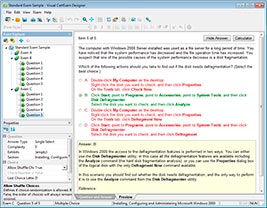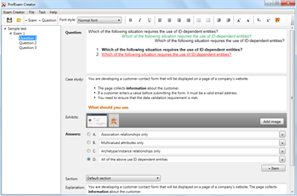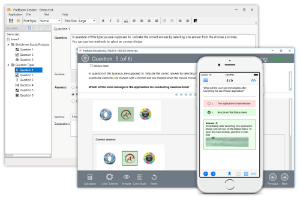Download Managing Supply Chain Risk.L5M2.PremiumDumps.2025-04-07.41q.vcex
| Vendor: | CIPS |
| Exam Code: | L5M2 |
| Exam Name: | Managing Supply Chain Risk |
| Date: | Apr 07, 2025 |
| File Size: | 307 KB |
How to open VCEX files?
Files with VCEX extension can be opened by ProfExam Simulator.
Purchase
Coupon: TAURUSSIM_20OFF
Discount: 20%
Demo Questions
Question 1
What is the purpose of the Sarbanes-Oxley Regulation?
- to protect the environment
- to ensure high levels of ethical practice with regards to working conditions
- to encourage transparency in financial reporting
- to ensure that products that reach the market are fit for purpose
Correct answer: C
Explanation:
Sarbanes Oxley Regulations encourages transparency in financial reporting. The regulations came in response to the Enron scandal in 2001 when Enron bosses were falsifying financial records to make the company look better than it was, then the company went bust. The point of Sarbanes Oxley is to ensure that this doesn't happen again- that business leaders report correct financial statements to shareholders. The study guide talks about this on p.42 but I'd recommend also watching this video as it gives a good background to the regulation: Sarbanes Oxley Regulations encourages transparency in financial reporting. The regulations came in response to the Enron scandal in 2001 when Enron bosses were falsifying financial records to make the company look better than it was, then the company went bust. The point of Sarbanes Oxley is to ensure that this doesn't happen again- that business leaders report correct financial statements to shareholders. The study guide talks about this on p.42 but I'd recommend also watching this video as it gives a good background to the regulation:
Question 2
The legal principle of insurable interest means which of the following statements are TRUE? Select TWO.
- it is possible to insure someone else's factory
- it is not possible to insure someone else's factory
- it is possible to insure your supplier's factory
- it is not possible to insure your supplier's factory
Correct answer: BC
Explanation:
Insurable Interest means that it is not possible to insure someone else's factory. The study guide explains that you can only take out insurance where you have at least partial ownership of that risk. Therefore option 3 is also correct as you have a partial risk if something were to happen to your supplier's factory. You can take out CBI insurance for this. see p.100-101 for further explanations of Legal Principles of Insurance Insurable Interest means that it is not possible to insure someone else's factory. The study guide explains that you can only take out insurance where you have at least partial ownership of that risk. Therefore option 3 is also correct as you have a partial risk if something were to happen to your supplier's factory. You can take out CBI insurance for this. see p.100-101 for further explanations of Legal Principles of Insurance
Question 3
Which of the following statements about binomial distribution are true? Select THREE
- there are only two outcomes
- they are based on continuous events
- there is only one outcome per event
- each trial has the same probability
- the events of one trial will impact on the next one
Correct answer: ACD
Explanation:
1, 3 and 4 are the correct options. Binomial is based on discreate events not continuous and it assumes the events of each trial are independent of one another. This YouTube video explains it all perfectly using the chance that an ice-cream cone is broken. It's a nice memorable example to help you remember what binomial distribution is and how it works: https://www.youtube.com/watch?v=3EZbX2ftCUk - it's a very memorable example and really helped me. You can also see more info in the cips textbook p.131 1, 3 and 4 are the correct options. Binomial is based on discreate events not continuous and it assumes the events of each trial are independent of one another. This YouTube video explains it all perfectly using the chance that an ice-cream cone is broken. It's a nice memorable example to help you remember what binomial distribution is and how it works: https://www.youtube.com/watch?v=3EZbX2ftCUk - it's a very memorable example and really helped me. You can also see more info in the cips textbook p.131
Question 4
Which of the following will you put into box 6?
- audit
- monitor
- insurance
- dual sourcing
Correct answer: D
Explanation:
The correct answers are as follows:Table Description automatically generated with low confidence The correct answers are as follows:
Table Description automatically generated with low confidence

Question 5
An interconnected supply chain would have what affect on the creation of a risk register?
- risks will be larger
- risks will sit with the procurement team
- actions to mitigate one risk, may create a new risk
- actions to mitigate risks will require a cross-functional team
Correct answer: C
Explanation:
Actions to mitigate one risk, may create another risk. This is a direct quote from p. 132 Actions to mitigate one risk, may create another risk. This is a direct quote from p. 132
Question 6
A company with a large risk appetite would do which of the following?
- take all risks
- take risks where it feels it will win more than it loses
- take few, well calculated risks
- avoid taking risks
Correct answer: B
Explanation:
2 is the correct answer. Risk appetite is the level of risk that an individual or organisation is comfortable taking (p.4). Having a large risk appetite does not mean that you want to take every risk (as that would be irresponsible), rather, a large risk appetite means you're more likely to gamble and take calculated risks, even though they might not pay off. A small risk appetite would describe options 3 and 4 - taking few risks, or none at all. 2 is the correct answer. Risk appetite is the level of risk that an individual or organisation is comfortable taking (p.4). Having a large risk appetite does not mean that you want to take every risk (as that would be irresponsible), rather, a large risk appetite means you're more likely to gamble and take calculated risks, even though they might not pay off. A small risk appetite would describe options 3 and 4 - taking few risks, or none at all.
Question 7
Petra Ltd is a manufacturer of upmarket baked goods and they have a range which is gluten free and therefore suitable for customers who have an intolerance of wheat. For this reason Petra Ltd is very strict about the ingredients that it sources. It's main supplier has provided written agreement that they will test all ingredients in their processing factory to ensure that they are suitable for the gluten free diet before delivery is made, and once delivery is made the materials will be deemed accepted by the buyer. Is Petra right to accept this arrangement?
- yes- this reduces the risk of unsuitable materials entering Petra's factory
- yes- this arrangement places the risk on the supplier rather than Petra
- no- Petra should arrange for additional tests to be conducted on the deliveries and only accept them once these tests have been completed
- no - this arrangement is unacceptable and Petra should void the contract
Correct answer: C
Explanation:
Petra should arrange for additional tests to be conducted. This question is based on a real example in the exam.In this scenario there is still significant risk for Petra even if the supplier is testing the materials. The supplier could miss something, or forge the results with disastrous consequences for Petra's customers. Moreover it would severely damage Petra's reputation. Therefore the wise thing would be for Petra to conduct additional tests in-house to ensure they are happy with the products and only then accept them. This could be an audit of10% of deliveries to ensure compliance. Acceptance Testing is discussed in the textbook on p.70 Petra should arrange for additional tests to be conducted. This question is based on a real example in the exam.
In this scenario there is still significant risk for Petra even if the supplier is testing the materials. The supplier could miss something, or forge the results with disastrous consequences for Petra's customers. Moreover it would severely damage Petra's reputation. Therefore the wise thing would be for Petra to conduct additional tests in-house to ensure they are happy with the products and only then accept them. This could be an audit of
10% of deliveries to ensure compliance. Acceptance Testing is discussed in the textbook on p.70
Question 8
Yusef is a new procurement manager at FRD Incorporated. He is looking through the Risk Assessments for his department and notices that the cause of the risk is not identified. Why might this be?
- this is a mistake - all risk assessments should specify the cause of the risk. He should raise this with his manager
- the organisation has a high risk appetite
- the organisation has not recorded cause for cultural reasons
- the organisation has completed the risk assessments incorrectly
Correct answer: C
Explanation:
This could be for cultural reasons within the company.135 states that sometimes causes of risk are not recorded as this could lead to a blame culture within the company. This could be for cultural reasons within the company.
135 states that sometimes causes of risk are not recorded as this could lead to a blame culture within the company.
Question 9
Fraud committed by an employee within a business is what type of risk?
- internal risk
- external risk
- procurement risk
- economic risk
Correct answer: A
Explanation:
This is an internal risk. A procurement risk would be issues with a supplier or contract, and economic risk would be exchange rate fluctuations etc. See p.118 for more information on internal risks- it's a known exam topic This is an internal risk. A procurement risk would be issues with a supplier or contract, and economic risk would be exchange rate fluctuations etc. See p.118 for more information on internal risks- it's a known exam topic
Question 10
What would happen if a company enacts its Contingency Agreement following a natural disaster?
- they will receive a financial pay-out
- they will receive operational help from a third party
- they will be able to claim on insurance
- they will be able to breach any contracts that it has
Correct answer: B
Explanation:
They will receive operational help from a third party is the correct answer. Unlike insurance, a contingency plan provides operational help, not just financial. This could be in providing an emergency workspace, helping to get IT systems back up and running or providing emergency air freight. This is explained on p.91-92 of the study guide They will receive operational help from a third party is the correct answer. Unlike insurance, a contingency plan provides operational help, not just financial. This could be in providing an emergency workspace, helping to get IT systems back up and running or providing emergency air freight. This is explained on p.91-92 of the study guide
Question 11
Which of the following is an example of hedging?
- dual-sourcing
- insurance
- audits
- risk assessments
Correct answer: B
Explanation:
Insurance is a form of hedging. Hedging is using a financial instrument to offset the potential risk of an adverse loss (p.93) none of the other options mentioned are financial instruments. Insurance is a form of hedging. Hedging is using a financial instrument to offset the potential risk of an adverse loss (p.93) none of the other options mentioned are financial instruments.
HOW TO OPEN VCE FILES
Use VCE Exam Simulator to open VCE files

HOW TO OPEN VCEX FILES
Use ProfExam Simulator to open VCEX files


ProfExam at a 20% markdown
You have the opportunity to purchase ProfExam at a 20% reduced price
Get Now!



